Types of Jewelry Clasps
How is a lobster like a fish hook?
In the world of jewelry, there are a wide variety of clasps, each with its own purpose and unique design. Whether you are searching for a replacement for a broken clasp or just looking to learn more about them, this article is for you.
History of Jewelry Clasps
Jewelry clasps are a small but important component of many types of jewelry like necklaces, bracelets, and anklets. Clasps allow for easy attachment and removal of the jewelry and provide a secure way to wear and display precious pieces. The history of jewelry clasps dates back centuries, and we can watch as clasps have evolved over time to meet the changing needs and preferences of different cultures and styles.
One of the earliest forms of jewelry clasps was the simple hook-and-eye clasp which was used by ancient Egyptians and is the oldest known clasp style. This type of clasp was often made from softer metals like gold or copper and used to fasten necklaces and bracelets. The hook-and-eye clasp was also used by the Greeks and Romans who often embellished them with gemstones and intricate designs.
In the 19th century, the development of new metalworking techniques and machinery led to the mass production of jewelry, and the demand for simpler, more affordable clasps grew. This led to the development of the spring ring clasp, which is still widely used today. The spring ring clasp features a small, spring-loaded mechanism that snaps shut to secure the jewelry.
Other types of jewelry clasps that emerged in the 20th century include the lobster clasp, which features a spring-loaded mechanism that opens and closes by pressing a small lever, and the toggle clasp, which consists of a bar that slides through a circular loop to secure the jewelry.
Today, jewelry clasps are available in a wide variety of designs, materials, and sizes to suit the needs and preferences of just about anyone. From simple hook-and-eye clasps to intricate and ornate designs to modern magnetic closures, clasps continue to play an important, if often overlooked, role in the jewelry that we wear every day.
Lobster Clasp (Trigger Clasp, Teardrop Clasp)
Lobster clasps are one of the most popular choices for people who want a well-rounded clasp that is relatively inexpensive, strong, and easy to use. They come in a huge variety of styles and shapes including the traditional oblong shape, hearts, teardrops, specialty designer styles, and more.
They have a simple spring tension mechanism that holds the clasp closed. When the trigger is pushed down, the clasp opens. When the trigger is released, the spring tension closes the clasp again.
PROS
Strength – Lobster clasps are sturdy and ideal for heavier chains.
Ease of Use – They are easier to use than some other styles (e.g. spring rings) because of their size and shape.
CONS
Size and Bulk – Lobster clasps can be a little bulky and heavy for thin light weight chains and can be a little more expensive than alternatives.
Ease of Use – Yes, this is also listed as a “Pro,” but if you have arthritis or other dexterity issues, lobster clasps (especially the small ones) can be difficult to use. There are specialized squeeze variations of the lobster clasp that help with this issue though, so feel free to contact us if you are having trouble working your clasp. We should be able to find a great solution for you.
Spring Ring (Circle Clasp)
Spring Rings are another very common style of clasp. They are used on virtually every variety of jewelry, and most chains under $100 come with a spring ring to help keep the cost of the overall chain down. If you have a chain that came with one of these, you can always upgrade it to a lobster clasp or other style later down the road.
They work similar to a lobster clasp with a simple spring loaded mechanism. Slide the clasp tab back to open the clasp and release it to let the clasp close.
PROS
Weight – Spring Rings are typically small and lightweight and so they don’t weigh down lightweight chains like other clasps can.
Simplicity – The overall design and look of spring rings is very minimal which can be a nice compliment to many jewelry styles.
Cost – As mentioned above, spring rings are one of the least expensive clasp options as they are lightweight and mass produced for modern jewelry.
CONS
Longevity – Spring rings tend to wear faster over time because they are made to be lightweight. If this is a chain that you are taking on and off daily, spring rings will wear out faster than other styles.
Ease of Use – Spring rings can be quite difficult to operate due to their compact size and circular design. If you have trouble operating your spring ring, a lobster clasp is a natural replacement.
Box Clasp (Tongue and Groove Clasp)
Commonly found on bracelets and larger necklaces the box clasp is a high quality option that combines strength, aesthetics, and ease of use. A tubular “barrel” style of box clasp is often featured on lighter weight chains which you can see an example of in the Barrel Clasp section below.
A piece of folded metal called a tongue is pushed into the open box. The tension on the fold in the metal causes it to click into place once it is full inserted into the box. When it’s time to open the clasp the tongue is depressed (typically with a small push button) to allow it to slide back out of the box.
For most of our bracelets that we custom make, this is our clasp of choice. When paired with figure eight safety clasps and a safety chain it is one of the most secure options available.
PROS
Security – Box clasps fasten securely and as we mentioned above additional safeties can be added to further secure the clasp.
Design – The basic design of the box clasp can be made in a dizzying variety of styles. Designers can get creative and make the clasp an integrated part of the piece.
Ease of Use – This style is much easier than some of others to fasten with one hand. This is one of the reasons why they are often used on bracelets.
CONS
Longevity – The tongue (insert) can become loose over time and will need to be adjusted. If the tongue is made out of silver this can happen quite quickly.
Serviceability – If a box clasp does break, it can be difficult to find replacement parts that are the right size. There are just so many styles/sizes and many vintage clasps were custom made. That said, our team of experiences jeweler can often fabricate replacement parts for box clasps if needed, so don’t despair if your box clasp is broken.
Fold Over Clasp
The fold over clasp is an elegant design that allows for very easy operation and streamlined aesthetics. A hinged tab is threaded through an opening and then closed tight. Tension in the metal tab holds the hinged piece in place until it is pried up to open the clasp.
This style of clasp is commonly used on watches and wider bracelets. The design lends itself well to customization and it can be made to almost invisibly blend into a chain or bracelet by a skilled craftsman.
Fold over clasps are also preferred by people who struggle with lobster claws or spring ring clasps, which can be difficult to manipulate for those with arthritis or limited dexterity.
PROS
Ease of Use – This style is easy to operate with one hand, and it is low profile which makes it a good fit for bracelets and watches.
Style – Fold over clasps can be made in a huge variety of designs to fit the pieces that they are a part of. The clasp can become an integral part of the design.
CONS
Longevity – Like box clasps, a fold over is only as strong as the tension in the metal that holds it in place. Over time the clasp can loosen and need to be adjusted. Also, like box clasps, this loosening happens much faster with softer metals like sterling silver.
Adjustability – The bracelet needs to match your wrist size closely. Sometimes a second bar can be added to allow for small adjustments in length, but many styles don’t include this adjustment.
Serviceability – Because of the large variety of styles (many being custom made) it can be hard to source a matching style if it breaks (as with box clasps, our jewelers can generally make replacement parts if needed).
Risk of Damage – They require pulling hard enough to overload the clasp to open them which can put strain on delicate items. If you have to pull too hard to open the clasp, it may just need to be adjusted though. Bring it in to your local jeweler to have them check it out.
Strand Fish Hook Clasp (Pearl Clasp)
At first glance you might thing this style of clasp is something like a sideways box clasp. Indeed, some box clasps do come in shapes like this, but the fish hook clasp works slightly differently.
The tongue of the clasp is first threaded through the openings in the box side before it is pushed to click into place. This extra step allows the clasp to function as its own safety. If the tension in the clasp fails, the hook design should catch and prevent the clasp from opening fully.
It is a clever and beautiful design that is most often found on pearl strands, but it can work with most chain designs.
PROS
Style – This is a delicate, low-profile fastener that enhances the look of the pearl strand or other jewelry that it is used with. There are many elegant design options often featuring intricate filigree metal work.
Security – The double lock catch makes it more secure than similar clasps that don’t feature a safety mechanism.
CONS
Ease of Use – This style can be hard to clasp, especially behind one’s head. Open filigree can make it hard to know if you are latching it in the right area.
Strength – Heavy necklaces can pull the first catch out since it is held in by tension in somewhat thin metal.
Longevity – Since the main clasp mechanism works like a box clasp it suffers from the same problem of losing tension overtime. If this happens, the clasp can usually be adjusted or it may need to be replaced if it has too much wear.
S Hook Clasp (M Clasp, W Clasp, Thai Hook, Baht Clasp)
The S hook in its many forms is a simple and ancient design that features no springs and no moving parts. The clasp holds together by virtue of the strength of the wire to hold its curved shape alone.
S hooks usually work best in higher karat gold (21k and higher) because they are more malleable and don’t get brittle over time as easily. Unsurprisingly, one common use of this style of clasp today is with Thai Baht chains that are typically made with high karat gold.
PROS
Ease of Use – The simplicity of S hook clasps make them easy to fasten with one hand.
Style – There are many design options and jewelers have been creatively making new designs for centuries.
CONS
Security – S hooks are not the most secure clasp due to their inherently open design. If the chain is pushed or caught in the wrong way, they can open inadvertently.
Longevity – Since operating the clasp requires bending the metal to some extent they can get stretched out and become less secure over time.
Toggle Clasp (T-Bar Clasp)
This is another clever and simple design. A toggle clasp features an open circle (or other design) on one end and bar on the other that is slightly longer than the diameter of the circle. The bar is folded in line with the chain to thread it through the circle and then allowed to swing out to catch the edges of the circle. It is a very elegant design that works surprisingly well, but it does have some drawbacks.
For example, one common request that we get with toggle clasps is to remove the jump rings leading up to the toggle bar. Unfortunately, this is not always possible because these rings are typically required to make the clasp work. Without them, you would not be able to slide the toggle bar through the opening (unless the chain itself is thin enough to slide through). This isn’t really a problem with toggle clasps in general, but it is something to be aware of when you are buying one.
PROS
Ease of Use – Toggles are easy to fasten with one hand due to their simple design.
Longevity – These clasps have no moving parts, springs, or tension. There is very little that can actually wear out on a toggle clasp outside of the metal itself.
Style – There are many options for designs and the clasps themselves have a design aesthetic that fits many piece of jewelry. Sometimes the entire piece is designed to feature the look of the toggle clasp.
CONS
Security – As you may have guessed from their design toggles are not the most secure clasp style. If the toggle bar swings the wrong way at the wrong time, the clasp can simply come open. Because of this, safety chains are sometimes added to toggle clasp to give them an extra layer of security.
Comfort – Toggle clasps requires a looser fit so the chain can pass through the loop and then slide back to hold in place. This is, of course, a matter of preference, but if you prefer a snugger fitting bracelet, you may want to look for a different clasp style (like a fold over clasp).
Barrel Clasp (Threaded Clasp, Screw Clasp)
The barrel clasp is not as common as some of the others listed here, but it is a good, secure option that definitely deserves to be mentioned. The design is very simple featuring a threaded post on one side and a threaded recess on the other (like a nut a bolt). One side of the clasp is simply screwed into the other to close it and unscrewed to open it.
Note that the yellow gold barrel clasp pictured above actually works like a box clasp however this tubular style is often called a barrel clasp so we’re including it here.
PROS
Security – Barrel clasps tend to be secure and low profile. While they can work themselves loose over time, the snug fit of the threads is usually more than strong enough to keep them closed in normal wearing circumstances.
Longevity – There are no moving parts or springs to wear out over time. It is likely that the metal rings that attach the clasp to the rest of the chain will wear out before the clasp itself does.
CONS
Ease of Use – Barrel clasps require two hands to fasten, and it can be hard to line up the threads correctly. If the clasp is cross-threaded, that longevity we talked about before goes out the window.
Compatibility – Using a barrel clasp requires the cord or chain to be twisted. This can make them unsuitable for some chain styles.
Push Release Clasp (Push Button Clasp)
This style is somewhat similar to the box clasp. There is a notched post on one end of the clasp which fits into a catch on the other end. A simple squeeze of the fingers opens the mechanism and releases the clasp. While it is not as common as some of the other options shown here, this clasp does provide a nice balance between ease of use and security.
PROS
Style – Push release clasps typically have a sleek, low profile which allows them to integrate cleanly into the design of the piece that they are used on. Designers can also add patterns and textures to further enhance the look of the clasp.
Ease of Use – This is the main reason to choose a push release clasp over another style. Opening the clasp simply requires squeezing it together.
CONS
Availability – Push release clasps are much less common than other styles, and so your design options may be limited. This also impacts the price of the clasp and the ability to find a replacement, if it ever fails.
Longevity – As with other clasps that depend on a spring, eventually push release clasps will wear out and need to be replaced.
Magnetic Clasp
Even the easiest to use clasps that we have already discussed still require a certain level of dexterity to operate. If you have arthritis or just don’t like fiddling with tiny mechanisms to wear your jewelry, magnetic clasps are great alternatives. They can even be added in conjunction to or as a replacement for other styles of clasps (often times without having to modify the piece of jewelry at all).
Each side of the clasp has a magnet of opposite poles. When the two sides are brought in proximity the magnetic force between them pulls and holds them together. To open the claps you simply need to pull them hard enough apart.
PROS
Ease of Use – This is really the raison d’etre for magnetic clasps. They are incredibly easy to put together and open with one hand and/or behind one’s back. They can allow people with dexterity issues to continue to wear the jewelry that they love.
Longevity – There are no moving parts or springs to wear out. Sometimes the magnets themselves are held into the clasp by glue which can fail over time, however. If this happens, it is generally very straightforward to glue the magnet back in to place.
CONS
Security – Since they come apart simply by pulling, magnetic clasps are not as secure as other options, especially with heavy jewelry.
Weight – Magnetic clasps are comparatively heavy, and they will tend to pull down on lighter weight chains.
Style – Design choices are somewhat limited, and the clasp may not incorporate well with the look of the piece it is being worn with.
So, there you have it, a quick tour through the wonderful world of jewelry clasps. We hope this article has been helpful to you, and feel free to leave a comment below with your clasp stories or contact us if you have any questions. Remember that our team of in-house jewelry experts is always ready to help if you need a clasp repaired or replaced or if you have any other jewelry needs.
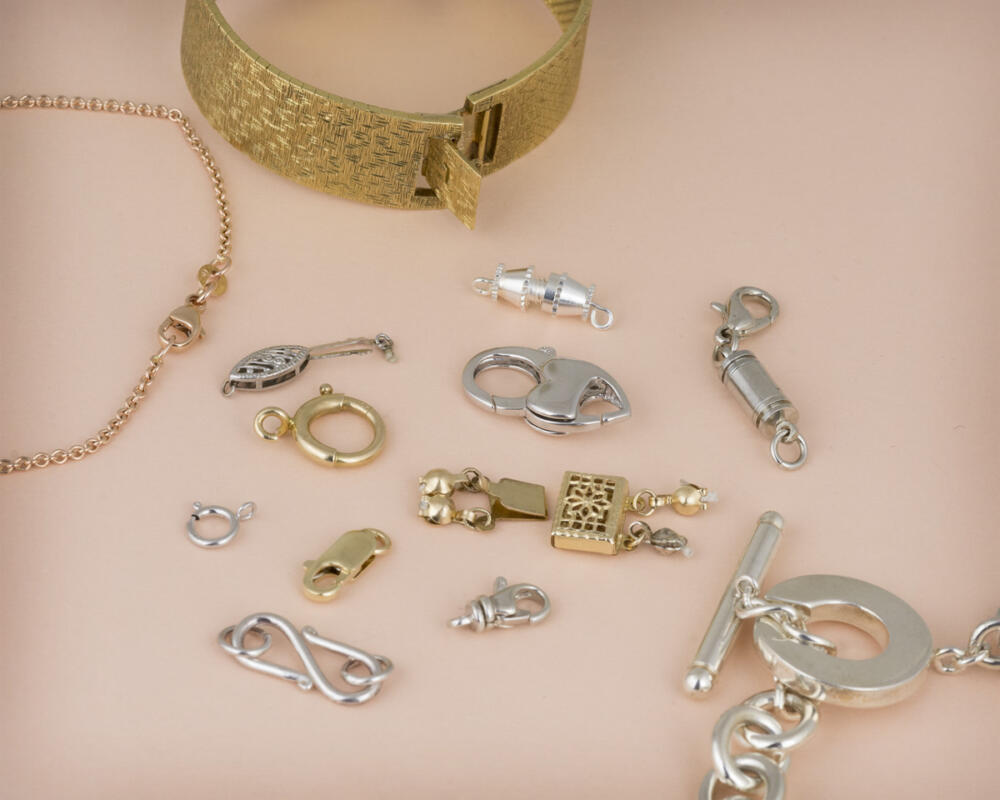
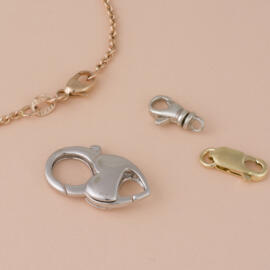
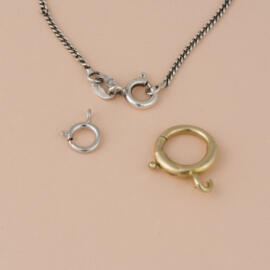
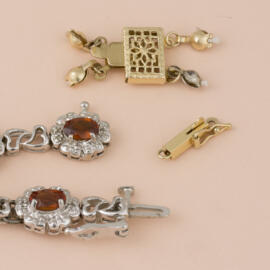
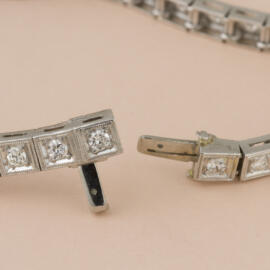
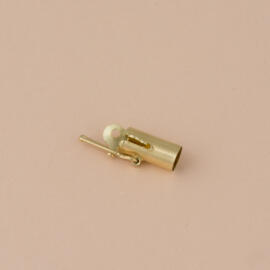
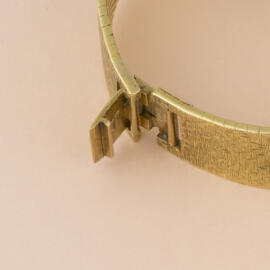
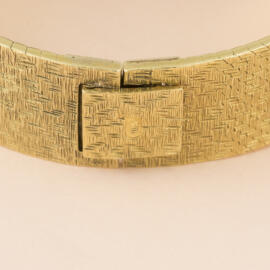
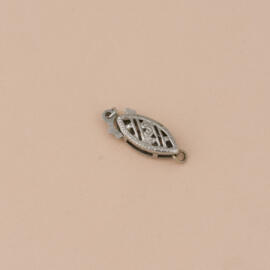
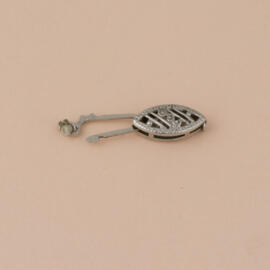
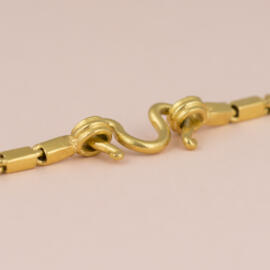
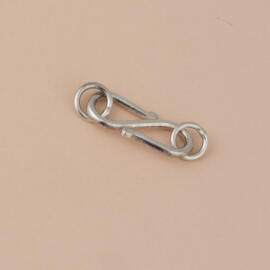
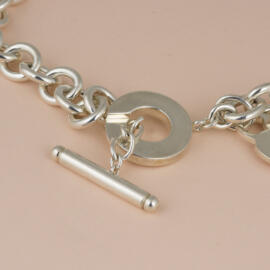
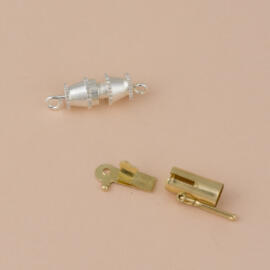
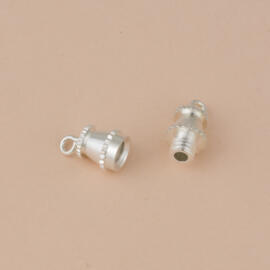
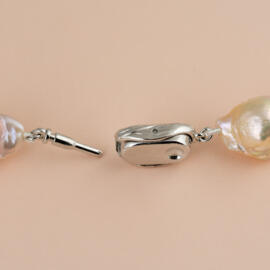
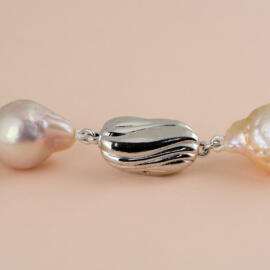
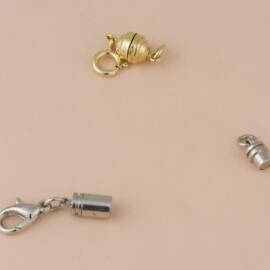
I’ve been searching for the push button clasp for a long time. Used to incorporate it in many designs. It is especially easy for those with less hand/finger agility. Now that you have helped me put a proper name on it, I am confident that I can find this wonderful clasp. Thank you!
Thanks for the kind words! I’m so glad to hear that the article was helpful to you. Yes, the push button clasps are great for easy of use.
Looking for 14k barral connecter for clasp to hook to
Hi James, thanks for reaching out. That sounds like something we should be able to help with. If you are in the Sacramento area, feel free to bring the piece by our shop, and we can take a look. Otherwise, you can email us some pictures, and we can go from there.
Wow! I was so impressed with this article. Who knew how many different types of clasps there are? I do enjoy your newsletters very much.
Thanks for the kind words, Vicki! I’m so glad you enjoyed it. 🙂
Thank you for sending me this very informative article I buy and sell on ebay and it is good to be able to name the clasp on an item
Regards
Janice
You are very welcome, Janice! I’m happy the article was helpful to you.